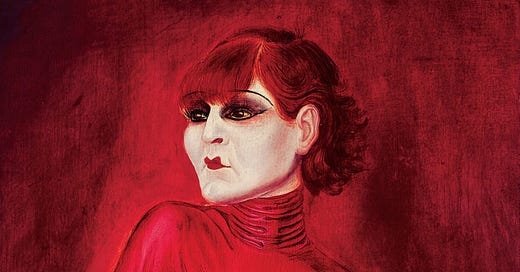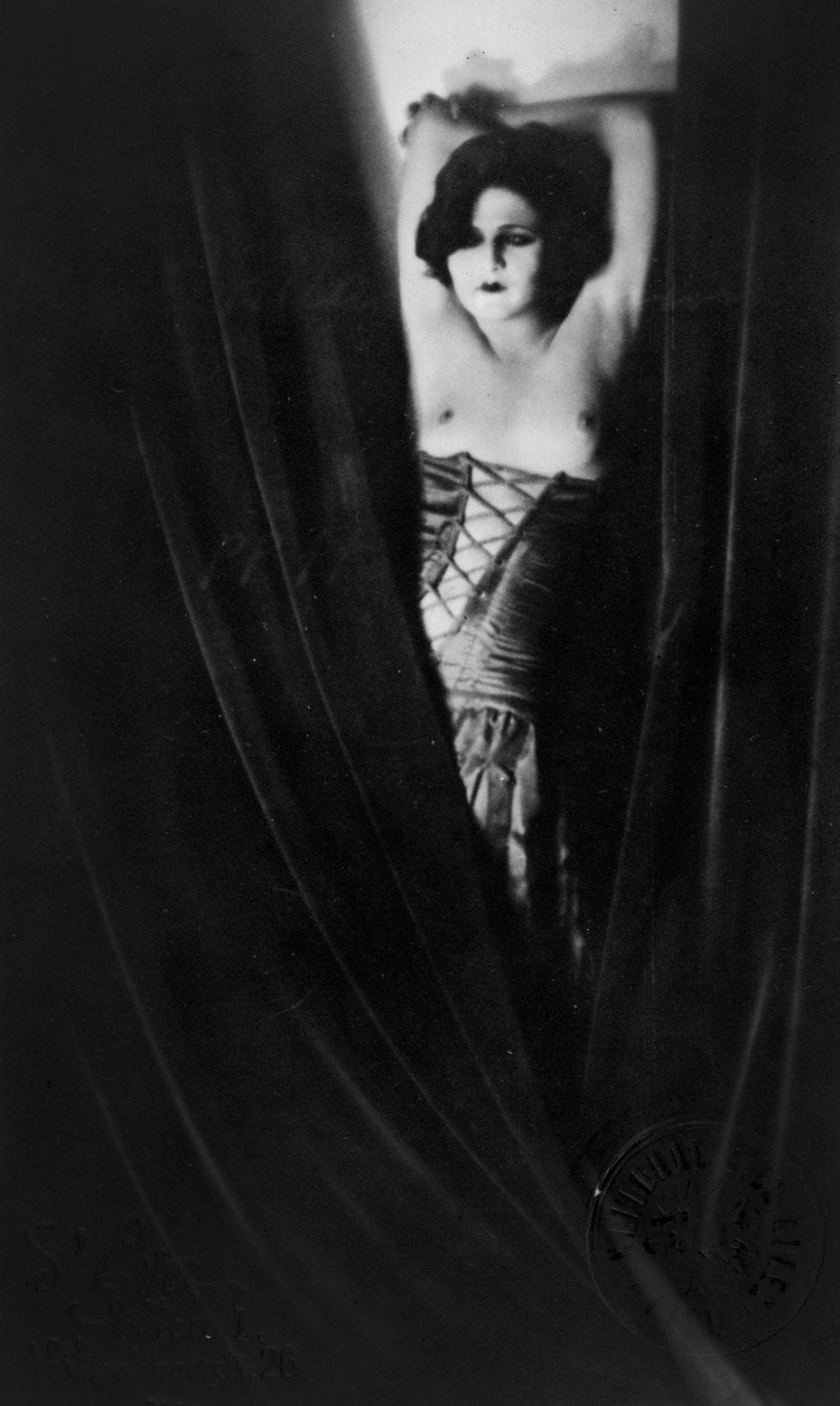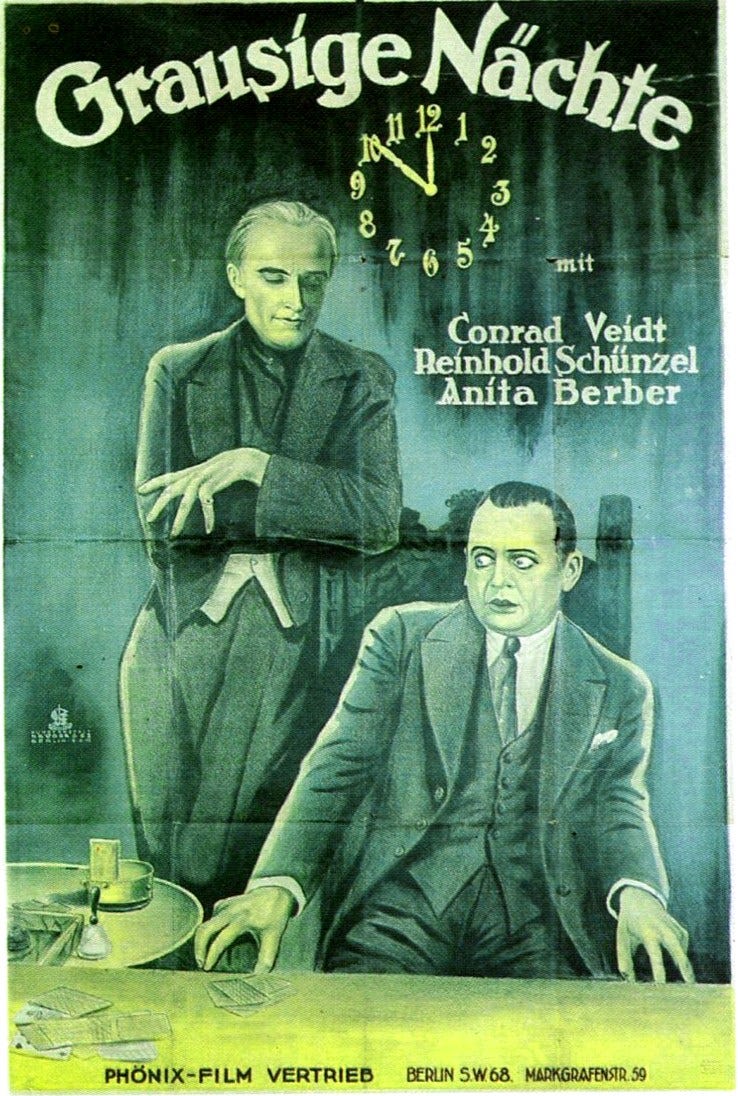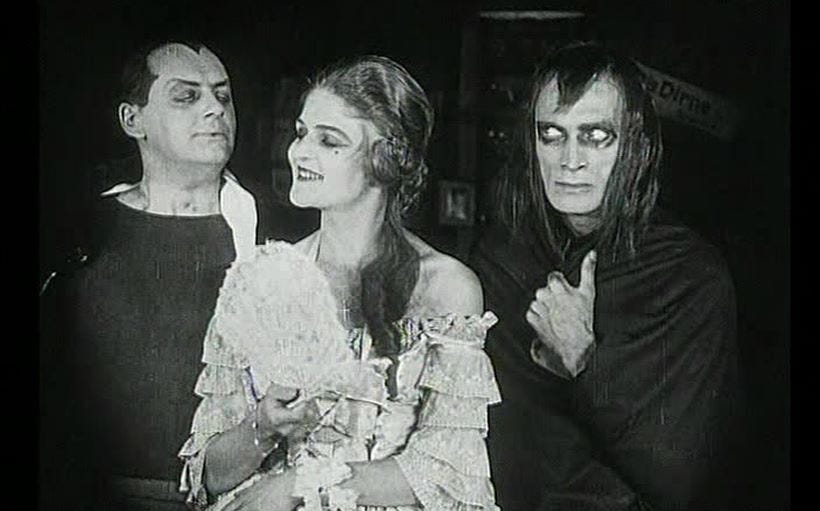ANITA BERBER Shocked Weimar Germany! #2: EERIE TALES: She stars in a new horror genre!
Anita's life falls apart, but she leaves behind the anthology horror genre!
If you missed part 1:
The Nutcracker, it was not. Conservatives were scandalized that Berber dared to make her addiction into art but respected writers like Max Hermann-Neiße were blown away, “In the short period of time her performance lasts, she has mounted a revolt.”
Then Droste got arrested for passing a forged credit note for 50 million Kroner. They found a lawyer who managed to convince the court to let them work until the debt was paid. After settling this mess, it turned out that Droste had signed ‘exclusive’ contracts with three different theatres. The International Actors Union got involved and banned them from performing on any continental variety stage for two years. A few weeks later, Droste got arrested again for stealing from two countesses (because apparently one wasn’t enough). This time, Berber had to put up her furs and jewels to get him out on bail. When she attempted to steal the furs and jewels back, a porter tried to stop her and she punched him in the face. Droste and Berber were both deported from Austria.
They returned to Berlin, where Droste stole Berber’s jewels and bailed. He was next seen in New York, pretending to be a baron and trying to get D.W. Griffiths interested in a film project. In 1927, he returned to his parent’s house in Hamburg and died of tuberculosis. Berber wouldn’t live through the decade either.
Anita’s drug habit was now out of control, thanks to two years with Droste. Still banned from high-end variety stages, she took to cabarets where she began to raise eyebrows for her belligerence. In 1923, she hit a disrespectful audience member at the Weiss Maus on the head with a champagne bottle and then urinated on his table. It seems that Berber believed she was giving him art but the philistine wanted a lap dance. In an interview with the Berlin journalist Fred Hildenbrandt, she sneered, “We dance death, illness, pregnancy, syphilis, madness, dying, infirmity, suicide, and nobody takes us seriously. They just stare at our veil to see if they can see anything underneath, the pigs.”
A bright spot in her life was gay dancer Henri Châtin-Hofmann. They were married in 1924 two weeks after they met. Châtin-Hofmann took over the management of his wife’s career and attempted to get her to clean up her act, but there were no brakes on this train. In 1925, Otto Dix painted his famous portrait of Anita Berber in a slinky red dress. Dix’s wife Martha recalled that Berber “spent an hour putting on her make-up and drank a bottle of cognac at the same time.” The writer Klaus Mann remembered, “People were pointing the finger at her, she was outlawed. Even for post-war Berlin she had gone too far. One went to see her on the cabaret stage to get the creeps; apart from that, she was ostracized.”
Unable to find performance spaces to book them, Châtin-Hofmann and Berber went to Yugoslavia in 1926 with a revamp of Dances of Vice. In Zagreb, Berber allegedly insulted the Yugoslavian king and was jailed for several weeks. From there, they went to the Netherlands to perform in a new revue, with Châtin-Hofmann finally succeeding in getting Berber to stop drinking. They then set off on a Middle Eastern tour from Damascus to Cairo to Beirut. At the end of a show in Beirut, Berber collapsed onstage and was diagnosed with advanced pulmonary tuberculosis.
The journey back to Berlin took four months with Berber needing to rest at every leg of the journey. In Prague, they ran out of money and friends took up collections at cabarets to get Berber back home. A week after arriving at the Bethanien Hospital in Berlin, Berber died at the age of 29. “She never did half a thing,” Klaus Mann wrote in 1930, “Her crash, rapid and catastrophic, seems magnificently stylized, pathetically heightened like her triumph before.”
When the Nazis came to power in 1933, they classified Dix’s painting of Berber as degenerate and buried all mention of queer and radical Germans. It was only in the 1980s that interest in her revived. Since then Anita Berber has regained her cult status as poster child for Weimar decadence. As she herself wrote in Dances of Vice,
“I kissed and tasted each one until the end / All all died of my red lips.”
About the writer: Born to a Taiwanese family in NYC’s Lower East Side, Victoria Linchong grew up with a natural instinct to investigate obscure history and secret places. Her mission in life is to rewrite Western history to include women and people of color, after which she will retire to an alpaca farm with a hundred stray cats. As burlesque performer Viva Lamore, she performs internationally and hosts historical web series in vintage drag. Copy Via MESSY NESSY.
Anita left behind a film that would introduce a whole new genre of horror film. EERIE TALES was the very first horror anthology movie, long before TALES FROM THE CRYPT, THE VAULT OF HORROR, TRILOGY OF TERROR, etc.
This film started a horror genre still with us today.
Anita Berber, Reinhold Schünzel, and Conrad Veidt in EERIE TALES.
From Wikipedia:
Unheimliche Geschichten (EERIE TALES) was directed, produced and co-written by Richard Oswald. The film stars Anita Berber, Reinhold Schünzel and Conrad Veidt as the Harlot, the Devil and Death in the opening sequence, but they also play various other roles in each of the five stories. Each story was based on an author's work, including Anselm Heine (The Apparition, 1912), Robert Liebmann (The Hand), Edgar Allan Poe (The Black Cat, 1843), Robert Louis Stevenson ("The Suicide Club", 1878) and Richard Oswald's own contribution (Der Spuk/ The Spectre).
Watch the movie here:
Behind the paywall: Fashions Of The Weimar Years
People often ask me which moment in the past do I think has had the greatest impact on fashion today. Without hesitation, I answer; 'The Weimar Republic!' The 'divine decadence', cabaret scene, sexualization and 'the outsider as insider' of Germany 1919-1933 gave birth to some of fashion's most immediate signifiers. So WILKOMMEN to this Ultimate Fashion History special.
Keep reading with a 7-day free trial
Subscribe to Classics Of The Silent Screen to keep reading this post and get 7 days of free access to the full post archives.









